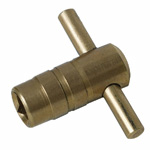Bleeding a Radiator
Introduction
Air can enter your central heating system whilst the water level in it is being topped up. This trapped air can reduce the amount of heat radiated, and in some cases, prevent some parts of the heating system from working all together.
You can tell if a radiator has trapped air in it by feeling the temperature of the top and bottom while the heating is turned on. If top is significantly cooler than the bottom, the radiator needs bleeding. If the radiator is almost completely full of air, no difference in temperature between the top and bottom will be felt, but in these extreme cases, the whole radiator will be cool.
Note: If you plan to bleed a radiator in a sealed system you will reduce the overall pressure of the entire system, this shouldn't be a problem if you top up the system afterwards from the main cold water feed.
Tips for bleeding a radiator
To bleed a radiator simply observe the following;
- Having turned the heating on to get warm water into the radiator, switch off the central heating system.
- Fit a bleed key onto the bleed valve, which is usually found at one end on the top of the radiator.
- Wrap an old rag or towel around the key and valve to catch any bleed water.
- Turn the bleed key anticlockwise through half a turn to open the valve. You will hear a hissing sound as the trapped air escapes the system.
- Shut off the valve when water begins to dribble, by retightening the key half a clockwise turn.
- If the central heating system is a sealed system, check the pressure and top up where necessary.

Further links and useful information
- Radiators
- Hanging radiators
- Radiator thermostats and valves
- Painting & decorating radiators
- More plumbing & heating topics
- Find a Radiator Supplier near you
- Find a Plumber near you
- Find a CORGI Gas Engineer near you
- The Gas Safety Register (gassaferegister.co.uk)
- Gas Regulations (odpm.gov.uk)
Site Pages
Featured Articles





